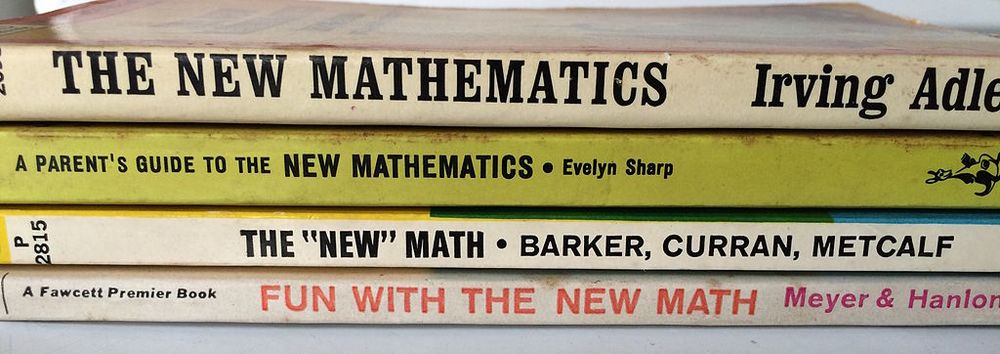The launch of Sputnik by the Soviet Union in 1957 sent the Americans into panic. Lawmakers and educators became worried that the United States were falling behind the Soviets, and if something wasn’t done to boost science education and mathematical skill of students and future scientists, the nation could not win back the technological ground it appeared to have lost to the Soviets.
The very next year, President Eisenhower signed the National Defense Education Act, and the Congress poured money into the American education system at all levels. Every high school subject from biology to chemistry was reformed, but it was mathematics which was hit the hardest.
An American elementary school classroom in the 1960s. Photo: Richey Elementary School
Edward Begle, a math professor at Yale, was asked to lead the newly formed School Mathematics Study Group, which was tasked with creating and implementing mathematics curricula for primary and secondary education. The efforts of the SMSG yielded a reform in mathematics education known as New Math. As explained by Encyclopedia.com:
New Math stressed conceptual understanding of the principles of mathematics and de-emphasized technical computing skills. With New Math, out went the rote drill and practice of math facts and formulas. Instead, along with a whole new vocabulary of terms related to mathematical operations, students were taught abstract concepts involving operations on sets of numbers grouped by their characteristics and properties. The intended focus of New Math was to teach children basic mathematical truths that they would then be able to apply to specific problems in a rapidly specializing scientific and technical world.
“Set theory took a central role, forcing students to think of numbers as sets of objects rather than abstract symbols to be manipulated”, writes Kevin Knudson, Professor of Mathematics, University of Florida. “This is actually how numbers are constructed logically in an advanced undergraduate mathematics course on real analysis, but it may not necessarily be the best way to communicate ideas like addition to schoolchildren.”
Aside from set theory, young kids that could barely do multiplication were forced to learn abstract algebra, modular arithmetic, matrices, symbolic logic, Boolean algebra, and other complex stuff they might never need.
A collection of New Math paperbacks from 1960s. Photo: Jengod/Wikimedia Commons
Encyclopedia.com gives an example of how a simple problem asking students to calculate the profit realized after the sale of some goods (widgets in this case) might have to be reworded according to the dictates of New Math:
A set of widgets (designated as set W) was exchanged for a set of money (designated as set M). The cardinality (the number of elements in a set) of set M was equal to 20—with each element (i.e., currency) being equal to one (e.g., a monetary denomination of $1). If x's are used to designate the elements of each set, then set P (representing manufacturing costs) has eight fewer x's than set M. Represent set P as a subset of set M and determine the cardinality of the elements to determine the profit realized from the sale of widgets.
Such densely complex problems was too far too difficult for elementary students to grasp, and outside of students' ordinary experience. Many parents complained they were incapable of helping their children with homework because they did not understand what their children were learning. Even teachers struggled to understand these new concepts.
Professor George Simmons wrote that the New Math produced students who had “heard of the commutative law, but did not know the multiplication table.”
Cartoonist Charles Schulz pokes fun at New Math.
In the new geometry book, there was a theorem with proof, taking up half a page, stating that with three points on a line, one point must lie between the other two. While this a necessary theorem for a foundations course in geometry, it has no place in an elementary text. George Pólya, who was one of many mathematicians who publicly criticized the new curriculum, said that had he been asked to study the proof of such a theorem in high school, he would almost certainly have given up on mathematics.
Morris Kline in his book, Why Johnny Can't Add: The Failure of the New Math, said that the curriculum “ignored completely the fact that mathematics is a cumulative development and that it is practically impossible to learn the newer creations, if one does not know the older ones.”
In the face of mounting criticism from teachers, students, scientists and educationalists, New Math fell out of favor. Some educators argued that the concept itself was beneficial, but the fault lay in the implementation process.
In the essay New Textbooks for the "New" Mathematics, physicist Richard Feynman had the following advice for educators:
In the "new" mathematics, then, first there must be freedom of thought; second, we do not want to teach just words; and third, subjects should not be introduced without explaining the purpose or reason, or without giving any way in which the material could be really used to discover something interesting. I don't think it is worth while teaching such material.
References:
# Mark Palko, Education Reform is the new New Math, Washington Post
# American Public Schools Begin Teaching New Math, Encyclopedia
# Richard Feynman, New Textbooks for the "New" Mathematics, PDF
# Kevin Knudson, The Common Core is today’s New Math – which is actually a good thing, The Conversation
# New Math, Wikipedia















What was really done --- speaking as a man who as a child was the focus of the post sputnik education system -- was that very bright kids were taken out of their normal classes and put into classes together known as "Accelerated Education." The was not a lot of "new math" presented... just algebra, geometry, solid geometry and basic calculus jammed onto the "brights."
ReplyDeletePerhaps "New Math" came along later but it was not one of the first things done by any means.